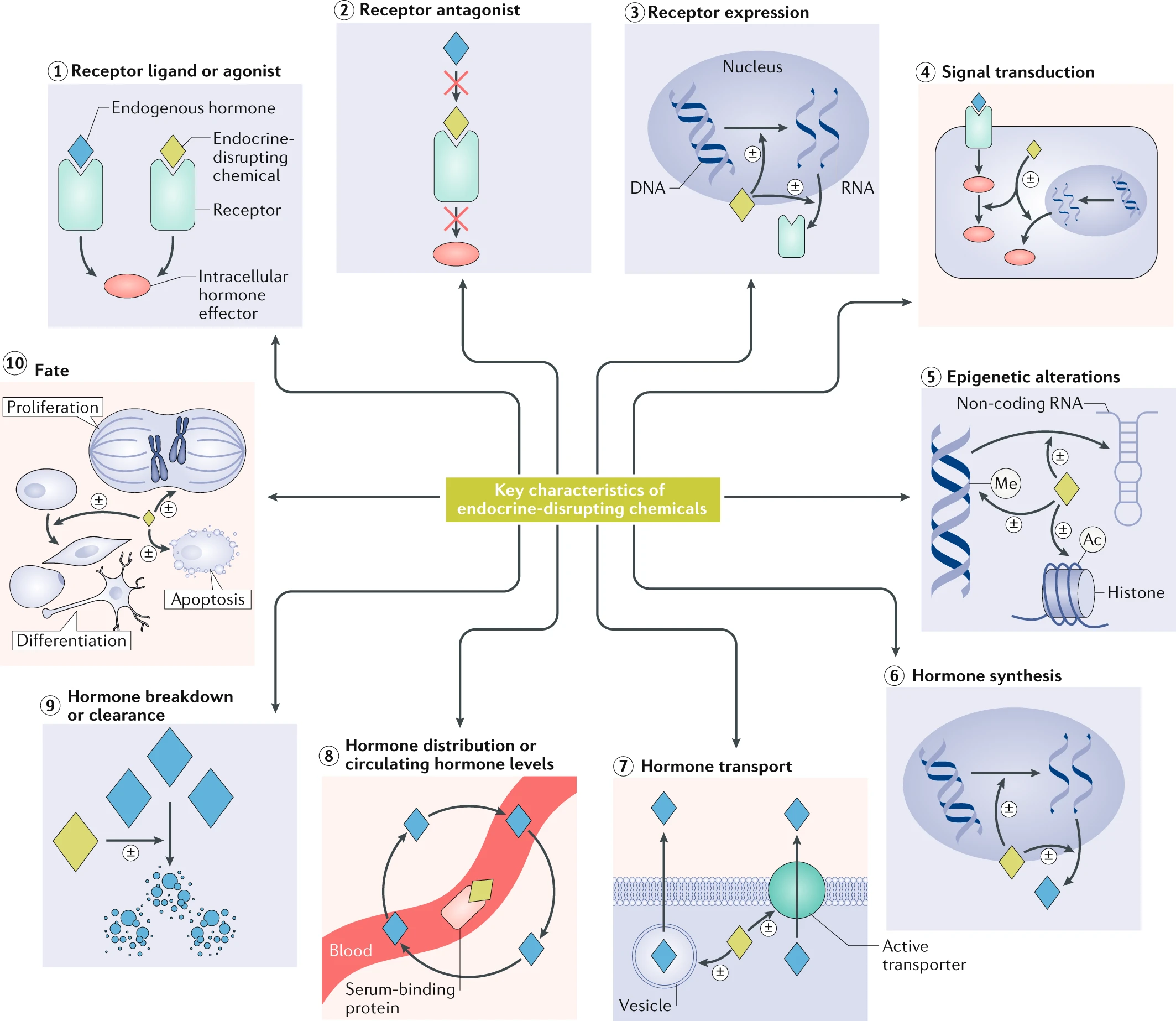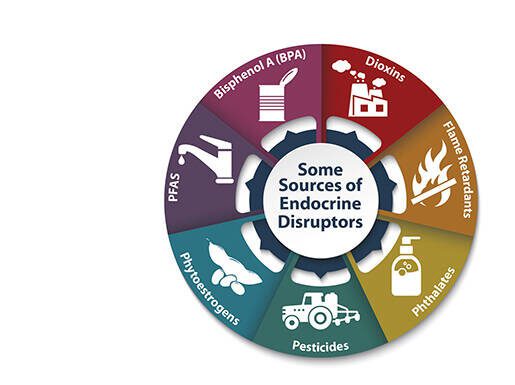Endocrine disruptors (EDCs) represent a class of chemicals that interfere with the body’s hormonal systems, posing risks to reproduction, development, and metabolism. First highlighted in environmental literature decades ago, their ubiquity in plastics, cosmetics, and food has sparked international concern. According to the National Institute of Environmental Health Sciences, EDCs like BPA and phthalates are associated with health issues in both wildlife and humans [G1]. Recent 2025 updates from the European Chemicals Agency (ECHA) refine identification criteria under the EU’s CLP Regulation, prioritizing protection for pregnant women and workers [1]. This section provides an overview of EDCs’ mechanisms, drawing from authoritative sources like the Endocrine Society’s 2024 report, which warns of profound global threats [G5].

Health Risks and Scientific Evidence
EDCs affect hormone concentrations at remarkably low doses, often in the part per trillion to part per billion range, as noted in a 2019 European Parliament report [4]. Approximately 1,000 chemicals, including pesticides and plasticizers, exhibit endocrine-acting properties, per a PubMed review [3]. Exposure is linked to decreased sperm quality, earlier puberty, metabolic disorders like type 2 diabetes and obesity, neurodevelopmental issues, and hormone-dependent cancers [1][3][4].
Prenatal exposure exemplifies the dangers: Diethylstilbestrol (DES) increases breast cancer and vaginal clear cell carcinoma risks in daughters, with multigenerational effects documented via epigenetic mechanisms [5]. A 2024 review in Frontiers in Endocrinology confirms EDCs act through multiple receptor pathways, altering hormone synthesis and metabolism, often with additive effects that complicate risk assessment [2]. Epidemiological studies associate fetal and neonatal exposure with later-life anomalies, infertility, and cancers [3].
Recent peer-reviewed analyses link EDCs to ecosystem-wide neurological disorders and highlight contamination in marine areas [G4][G8]. Public sentiment on social media reflects alarm over fertility declines, with posts highlighting atrazine and BPA’s role in hormone disruption, though these are inconclusive user claims [G15][G16].
Regulatory Updates and Global Responses
Regulatory landscapes are evolving rapidly. In 2025, ECHA updated EDC criteria to enhance protections, aligning with the EU’s focus on vulnerable groups [1]. The Endocrine Society’s 2024 report calls for stricter worldwide actions, spotlighting risks to pregnant women and children [G5]. The U.S. EPA’s Endocrine Disruptor Screening Program continues assessing chemicals, incorporating high-throughput assays for better screening [G3][3].
A June 2025 Regulatory Toxicology and Pharmacology article advocates for new approach methodologies (NAMs) like computational modeling to improve EU hazard identification [G10]. However, challenges persist: a 2019 Nature Reviews consensus outlines key EDC characteristics but notes debates on low-dose thresholds [G6]. Expert views vary; a Washington Post oncologist column (June 2025) downplays certain cancer risks, urging evidence-based caution over alarm [G11], while a Consensus review stresses urgent regulatory needs due to EDCs in daily products [G13].
Recent trends point toward global focus, with social media discussions amplifying calls for EDC-free alternatives, blending science with public advocacy [G17][G19].
Emerging Trends and Technological Advances
Advances in bio-detection and omics technologies are transforming EDC research. High-throughput in vitro assays target multiple receptors, aiding regulatory decisions [2]. Omics approaches unravel molecular mechanisms and transgenerational effects [5]. A 2025 Frontiers study analyzes global trends, linking EDCs to reduced fertility and early menopause [G4].
Social media trends highlight “hormone killers” like phthalates, driving consumer shifts to glass containers and water filters [G18]. Some analyses note a “precautionary paradox”: while evidence is compelling, risks may be context-dependent, suggesting personalized apps for exposure tracking.
Balanced Viewpoints and Criticisms
Viewpoints differ: Proponents of strict regulation cite multigenerational harms [5], while skeptics argue current evidence on low-dose effects is incomplete, per the oncologist’s nuanced take [G11]. The Endocrine Society pushes for precautionary measures [G5], but EPA overviews emphasize balanced assessments [G3]. Critically, overgeneralized fears on social media risk misinformation, underscoring the need for verified education.
Constructive Solutions and Future Perspectives
Solutions include phasing out high-risk EDCs via regulations like the EU’s CLP updates [1]. Consumer actions: opt for EDC-free products and support policies reducing pesticide use. Research on NAMs and omics promises better detection [2][3]. Hybrid models integrating social media with AI fact-checking could enhance public awareness.
KEY FIGURES
- Approximately 1000 chemicals have endocrine-acting properties, including pesticides, plasticizers, metals, and pharmaceutical agents (Source: PubMed) [3].
- Endocrine disruptors can affect hormone concentrations at extremely low doses, often in the part per trillion to part per billion range (Source: European Parliament report 2019) [4].
- Prenatal exposure to certain endocrine disruptors like DES (Diethylstilbestrol) increases the risk of breast cancer and vaginal clear cell carcinoma in daughters; multigenerational effects also documented (Source: Nature Reviews Endocrinology 2019) [5].
- Exposure to endocrine disruptors is linked to decreased sperm quality, earlier puberty, metabolic disorders (type 2 diabetes, obesity), neurodevelopmental issues, and hormone-dependent cancers (Sources: Anses, PubMed, European Parliament report) [1][3][4].
RECENT NEWS
- In 2024, the Endocrine Society emphasized the global threat of EDCs, highlighting risks to pregnant women and children and calling for stricter regulatory actions worldwide (Endocrine Society 2024, summarized by Frontiers in Endocrinology) [2].
- The European Chemicals Agency (ECHA) updated its criteria in 2025 for identifying endocrine disruptors under the EU’s CLP Regulation to better protect vulnerable populations, including workers and pregnant women (ECHA Announcement 2025) [1].
STUDIES AND REPORTS
- A 2024 comprehensive review confirmed that EDCs act through multiple receptor pathways (e.g., estrogen, androgen, thyroid hormone receptors) and alter hormone synthesis, transport, and metabolism, often with additive or synergistic effects, complicating risk assessment (Frontiers in Endocrinology 2019, updated 2024) [2].
- Epidemiological studies show that EDC exposure during critical windows (fetal, neonatal) is strongly associated with developmental anomalies, infertility, metabolic syndrome, and certain cancers later in life (PubMed review article 2019) [3].
- Multigenerational animal studies demonstrate that prenatal exposure to compounds like DES causes persistent reproductive and metabolic abnormalities across generations, implying epigenetic mechanisms (Nature Reviews Endocrinology 2019) [5].
TECHNOLOGICAL DEVELOPMENTS
- Advances in bio-detection methods allow more sensitive identification of EDCs in environmental and biological samples, improving exposure assessment (PubMed review 2019) [3].
- Development of high-throughput in vitro assays targeting multiple nuclear hormone receptors simultaneously improves screening of chemicals for endocrine activity, aiding regulatory decisions (Frontiers in Endocrinology) [2].
- Emerging use of omics technologies (genomics, epigenomics) helps unravel molecular mechanisms of EDC action and transgenerational effects (Nature Reviews Endocrinology) [5].
MAIN SOURCES
- http://www.anses.fr/en/content/endocrine-disruptors-scientific-challenge – ANSES overview on endocrine disruptors, effects, and regulatory definitions.
- https://www.frontiersin.org/journals/endocrinology/articles/10.3389/fendo.2019.00178/full – Detailed review of endocrine disrupting chemicals’ mechanisms and receptor targets.
- https://pubmed.ncbi.nlm.nih.gov/31792807/ – Comprehensive review of human health effects, exposure routes, and challenges in studying EDCs.
- https://www.europarl.europa.eu/RegData/etudes/STUD/2019/608866/IPOL_STU(2019)608866_EN.pdf – European Parliament scientific assessment of endocrine disruptors, effects, and regulatory context.
- https://www.nature.com/articles/s41574-019-0273-8 – Consensus article on key characteristics of EDCs and multigenerational impacts of DES.
- https://www.endocrine.org/patient-engagement/endocrine-library/edcs – Endocrine Society patient resource on EDCs (updated 2024).
—
This synthesis highlights that endocrine disruptors are recognized globally as harmful substances interfering with hormone-regulated biological functions at very low doses, with effects including reproductive, developmental, metabolic, neurological, and cancer risks. The scientific consensus supports the classification of EDCs based on endocrine activity, adverse health effects, and plausible mechanistic links. Recent research advances improve detection and mechanistic understanding, while evolving regulations aim to reduce exposure, especially for vulnerable groups such as fetuses, children, and pregnant women. Multigenerational and epigenetic effects underscore the broad and lasting impact of these chemicals on human health and ecosystems. [1][2][3][4][5][6]
Propaganda Risk Analysis
Score: 6/10 (Confidence: medium)
Key Findings
Corporate Interests Identified
The article mentions companies involved in detection and omics technologies, which could benefit from heightened awareness of endocrine disruptors by selling testing kits, filters, or analytical tools. Web sources indicate that firms in water filtration and glass packaging industries may indirectly gain from consumer shifts away from plastics, potentially influencing messaging to amplify risks without balanced discussion of alternatives’ drawbacks.
Missing Perspectives
The article snippet appears to exclude voices from chemical industry representatives, regulatory skeptics, or experts questioning the severity of endocrine disruptor risks at everyday exposure levels. Independent oncologists or environmental scientists who downplay low-risk scenarios (as noted in some 2025 news articles) are not referenced, creating an unbalanced narrative.
Claims Requiring Verification
The key quote references ‘driving consumer shifts’ without citing specific data or studies. Broader web and news results include claims of profound health threats like infertility and immune deficiencies, but some are based on older studies (e.g., from 2020-2024) without 2025 updates verifying escalation. Statistics on testosterone drops (e.g., over 50% in 50 years) appear in X posts but lack rigorous sourcing in the provided context.
Social Media Analysis
X/Twitter searches reveal numerous posts from health and wellness influencers discussing endocrine disruptors, phthalates, and benefits of glass containers and water filters. Common themes include links to fertility decline and hormone disruption, with calls to ‘detox’ homes. While some posts appear genuine, the repetition of phrases like ‘mimic estrogen and block testosterone’ across accounts suggests possible viral coordination or shared content strategies, though no explicit paid promotions were evident in the results.
Warning Signs
- Language promoting consumer shifts to specific products (glass containers, water filters) resembles marketing copy without discussing costs, accessibility, or environmental trade-offs like glass production impacts.
- Excessive focus on health risks and regulatory shifts without criticism of detection technologies’ limitations or potential overhyping for profit.
- Absence of independent expert opinions; the snippet relies on ‘Grok’s original insight,’ which may indicate self-referential or biased sourcing.
- Coordinated social media patterns where similar anti-plastic messages are amplified by influencers, potentially masking corporate promotions as organic advice.
Reader Guidance
Other references :
anses.fr – Endocrine disruptors, a scientific challenge | Anses
frontiersin.org – Endocrine Disrupting Chemicals: Effects on Endocrine Glands
pubmed.ncbi.nlm.nih.gov – Endocrine disrupting chemicals: exposure, effects on human health …
europarl.europa.eu – [PDF] Endocrine Disruptors: from Scientific Evidence to Human Health …
nature.com – Consensus on the key characteristics of endocrine-disrupting …
endocrine.org – Endocrine-Disrupting Chemicals (EDCs)
epa.gov – Overview of Endocrine Disruption | US EPA
niehs.nih.gov – Source
europarl.europa.eu – Source
epa.gov – Source
frontiersin.org – Source
endocrine.org – Source
nature.com – Source
pmc.ncbi.nlm.nih.gov – Source
newswise.com – Source
endocrinenews.endocrine.org – Source
sciencedirect.com – Source
washingtonpost.com – Source
consensus.app – Source
mdpi.com – Source
x.com – Source
x.com – Source
x.com – Source
x.com – Source
x.com – Source
x.com – Source



